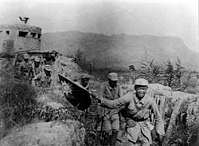
Back هجوم الأفواج المئة Arabic Ofensiva de los Cien Reximientos AST Бітва ста палкоў BE Битка на стоте полка Bulgarian Hundert-Regimenter-Offensive German Ofensivo de Cent Regimentoj EO Ofensiva de los Cien Regimientos Spanish صد هنگ متجاوز FA Offensive des Cent Régiments French Száz ezred harca Hungarian
| Hundred Regiments Offensive | |||||||
|---|---|---|---|---|---|---|---|
| Part of the Second Sino-Japanese War | |||||||
 Victorious Chinese Communist soldiers holding the flag of the Republic of China. | |||||||
| |||||||
| Belligerents | |||||||
| Commanders and leaders | |||||||
|
Peng Dehuai Zhu De Zuo Quan Liu Bocheng He Long Nie Rongzhen Deng Xiaoping | Hayao Tada | ||||||
| Units involved | |||||||
|
|
North China Area Army Collaborationist Chinese Army | ||||||
| Strength | |||||||
| 200,000[2] |
| ||||||
| Casualties and losses | |||||||
|
22,000[4]–100,000 (counting desertions)[5] Chinese figure (8th Route Army only): 17,000 casualties and more than 20,000 poisoned[2] |
Several record from different sources: 1. 30,000 Japanese and collaborators[10] | ||||||
The Hundred Regiments Offensive or the Hundred Regiments Campaign (Chinese: 百團大戰) (20 August – 5 December 1940)[11] was a major campaign of the Chinese Communist Party's National Revolutionary Army divisions. It was commanded by Peng Dehuai against the Imperial Japanese Army in Central China. The battle had long been the focus of propaganda in the history of Chinese Communist Party but had become Peng Dehuai's "crime" during the Cultural Revolution. Certain issues regarding its launching and consequences are still controversial.
- ^ Dillon, Michael (2014-10-27). Deng Xiaoping: The Man who Made Modern China. Bloomsbury Publishing. p. 79. ISBN 978-0-85772-467-0.
- ^ a b "说不尽的百团大战 (2)--中国共产党新闻--中国共产党新闻-人民网". Archived from the original on 2014-11-29. Retrieved 2014-02-05.
- ^ a b 中国抗日战争史(中) (in Chinese). 中国人民解放军军事科学院军事历史研究部. 1993.
- ^ a b c Chinese-Soviet Relations, 1937–1945; Garver, John W.; p. 120.
- ^ Tower of Skulls: A History of the Asia-Pacific War, Vol 1: July 1937-May 1942'; Frank, Richard B.; p. 161.
- ^ These two records were both based on the same figure but separate to two different records for unknown reason
- ^ 王人广《关于百团大战战绩统计的依据问题》(Wang Renguang <Issue of the basis of result statistics of Hundred Regiments Offensive >),《抗日战争研究 (The Journal of Studies of China's Resistance War Against Japan ISSN 1002-9575)》1993 issue 3, p. 243
- ^ Senshi Sosho 支那事変陸軍作戦Shina Jihen Rikugun Sakusen<3>(Volume 88) Asagumo Shinbun-sha, July 1975 ASIN: B000J9D6AS, p. 256
- ^ 『北支の治安戦(1)』ASIN: B000J9E2P6, p. 316
- ^ 彭德怀自述 (The Autobiography of Peng Dehuai) People's Press 1981 ASIN: B00B1TF388 p. 240
- ^ Peasant Nationalism and Communist Power: The Emergence of Revolutionary China 1937–1945; Johnson, Chalmers A.; p. 57.